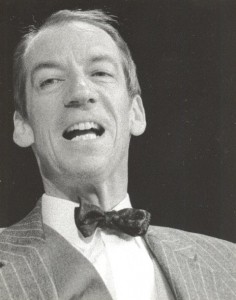 Joseph Kesselring (June 21, 1902 – November 6, 1967) was born in New York to German-born Episcopalian parents, Henry and Frances Kesselring. The family’s involvement in the church soon led to the discovery of young Joseph’s vocal talent; he became known throughout Manhattan as an outstanding boy soprano, then an outstanding tenor. At age eighteen, the young man received universally positive letters from churches and the New York Singing Teachers’ Association, recommending him for any music teaching position. These letters praised the boy’s “enthusiasm, talent, and experience,” and it seemed he had a bright future ahead, despite his lack of a high school degree or any specialized coursework in either music or teaching. When a distant family connection brought word that a teaching position had opened up for Joseph Kesselring in a Geary, Oklahoma high school, the young man packed up and went west.
Joseph Kesselring (June 21, 1902 – November 6, 1967) was born in New York to German-born Episcopalian parents, Henry and Frances Kesselring. The family’s involvement in the church soon led to the discovery of young Joseph’s vocal talent; he became known throughout Manhattan as an outstanding boy soprano, then an outstanding tenor. At age eighteen, the young man received universally positive letters from churches and the New York Singing Teachers’ Association, recommending him for any music teaching position. These letters praised the boy’s “enthusiasm, talent, and experience,” and it seemed he had a bright future ahead, despite his lack of a high school degree or any specialized coursework in either music or teaching. When a distant family connection brought word that a teaching position had opened up for Joseph Kesselring in a Geary, Oklahoma high school, the young man packed up and went west.
After just two years teaching in Geary, Kesselring joined the faculty of Bethel College in Newton, Kansas, a Mennonite institution of higher learning whose strict values were frequently at odds with Kesselring’s own. Compared to the conservative older professors on campus, the suave, self-taught, twenty-year old tenor stood out like a sore thumb, creating excitement and sometimes fear; though he was said to be an excellent teacher of both drama and music, rumors abounded concerning Professor Kesselring’s “forwardness” with female students during private voice lessons. Kesselring also ruffled feathers by openly admitting to students that he was working for pay, not for “higher ideals,” by attending public dances in the town, and continually smoking on school grounds. Within a year, Kesselring had earned himself a discharge from his position, and never returned to higher learning.
In the next few years, Joseph Kesselring worked as a private music teacher, musical director, actor, producer, and director, eventually moving to Niagara Falls to run a vaudeville theatre there. In his twenties he made his living bouncing between music, theatre production, and writing of all forms, from short stories to plays to poetry. He grew to prefer writing, so much so that by 1931, a year after his marriage to pianist Charlotte Elsheimer, he decided to abandon his life as a performer and director to focus on writing full-time.
Kesselring saw his first work produced not onstage, but in a 1933 film, Aggie Appleby, Maker of Men, which received tepid reviews but encouraged the developing writer. His first stageplay, There’s Wisdom in Women had a modest two-month run on Broadway in 1935; though accompanied by criticism that its writing was “old hat” and “amateur,” Kesselring was still encouraged to try his play Cross-town on Broadway in 1937; this play was an unfortunate flop, closing in just a few weeks. Still Kesselring persisted, sending his work to producers across New York. Eventually, the wife of producer Howard Lindsey, to whom Kesselring had sent a script titled Bodies in Our Cellar many months before, picked up the script at random and enjoyed it so much that she shared it with her husband. Mr. Lindsey then shared it with his producing partner Russell Crouse, and they proceeded to help Kesselring shape the play for production, tempering its melodramatic leanings and cleaning up the comedy (apparently eliminating crude comments about the smell in the titular cellar). In 1941, Kesselring’s re-titled Arsenic and Old Lace opened on Broadway. It was a complete smash, running for 1444 performances, delighting a New York audience facing down war and desperate for light laughter and dark comedy.
Kesselring wrote seven other plays in the remainder of his life, but none of them received – or perhaps merited – the same reception as Arsenic Old Lace, which became an instant “chestnut” of American theatre. Kesselring increased his hit’s reach by transforming it into a screenplay, which was quickly picked up and used in the classic 1944 film starring Cary Grant. The playwright was able to live on rights, royalties, and the rest of his writing for the remainder of his life, and died comfortably and quietly on November 6, 1967 in Kingston, New York.